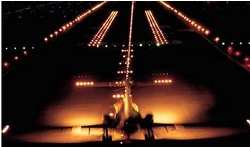Thu, Jun 29, 2006
Aero-Tips!
A good pilot is always learning -- how many times have you
heard this old standard throughout your flying career? There is no
truer statement in all of flying (well, with the possible exception
of "there are no old, bold pilots.")

Aero-News has called upon the expertise of Thomas P. Turner,
master CFI and all-around-good-guy, to bring our readers -- and us
-- daily tips to improve our skills as aviators. Some of them, you
may have heard before... but for each of us, there will also be
something we might never have considered before, or something that
didn't "stick" the way it should have the first time we memorized
it for the practical test.
Look for our daily Aero-Tips segments, coming each day to
you through the Aero-News Network.
Aero-Tips 06.29.06
Cool summer evenings broaden through red dusk into the night.
And you fly on. When must you turn on the lights?
FAR 91.209 tells us --
No person may, during the period from sunset to sunrise (or, in
Alaska, during the period a prominent unlighted object cannot be
seen from a distance of 3 statute miles or the sun is more than 6
degrees below the horizon):
-
 Operate an aircraft
unless it has lighted position lights
Operate an aircraft
unless it has lighted position lights
- Park or move an aircraft in, or in dangerous proximity to, a
night flight operations area of an airport unless the aircraft
-
- Is clearly illuminated;
- Has lighted position lights; or
- is in an area that is marked by obstruction lights;
- Operate an aircraft that is equipped with an anticollision
light system, unless the anticollision lights are on.
-
- However, the anticollision lights need not be lighted when the
pilot-in-command determines that, because of operating conditions,
it would be in the interest of safety to turn the lights off.
Note: This gives the pilot authority to turn
off strobes or other anticollision lights when they may interfere
with the pilot of another plane's vision during ground operations,
or when flying in reduced visibility, clouds or precipitation and
the anticollision lights induce distraction, disorientation or
unusual visual cues.
There are additional rules for seaplanes when anchored or
operating on the water.
Aero-tip of the day (or in this case, of the
night): Turn on anticollision lights when the sun goes
down, or anytime they will enhance others' ability to see and avoid
you.
More News
Also: Vertical Flight Society, NBAA Maintenance Conference, GA Honored, AMT Scholarship For the first time, students from Embry-Riddle’s Daytona Beach, Florida, campus took t>[...]
Hazardous Weather Information Summary of significant meteorological information (SIGMET/WS), convective significant meteorological information (convective SIGMET/WST), urgent pilot>[...]
"The need for innovation at speed and scale is greater than ever. The X-62A VISTA is a crucial platform in our efforts to develop, test and integrate AI, as well as to establish AI>[...]
(FAA) Inspector Observed That Both Fuel Tanks Were Intact And That Only A Minimal Amount Of Fuel Remained In Each Analysis: According to the pilot, approximately 8 miles from the d>[...]
“Pyka’s Pelican Cargo is unlike any other UAS solution on the market for contested logistics. We assessed a number of leading capabilities and concluded that the Pelica>[...]
 Airborne-Flight Training 05.09.24: ERAU at AIAA, LIFT Diamond Buy, Epic A&P
Airborne-Flight Training 05.09.24: ERAU at AIAA, LIFT Diamond Buy, Epic A&P ANN's Daily Aero-Term (05.07.24): Hazardous Weather Information
ANN's Daily Aero-Term (05.07.24): Hazardous Weather Information Aero-News: Quote of the Day (05.07.24)
Aero-News: Quote of the Day (05.07.24) NTSB Final Report: Cessna 150
NTSB Final Report: Cessna 150 Aero-News: Quote of the Day (05.08.24)
Aero-News: Quote of the Day (05.08.24)




